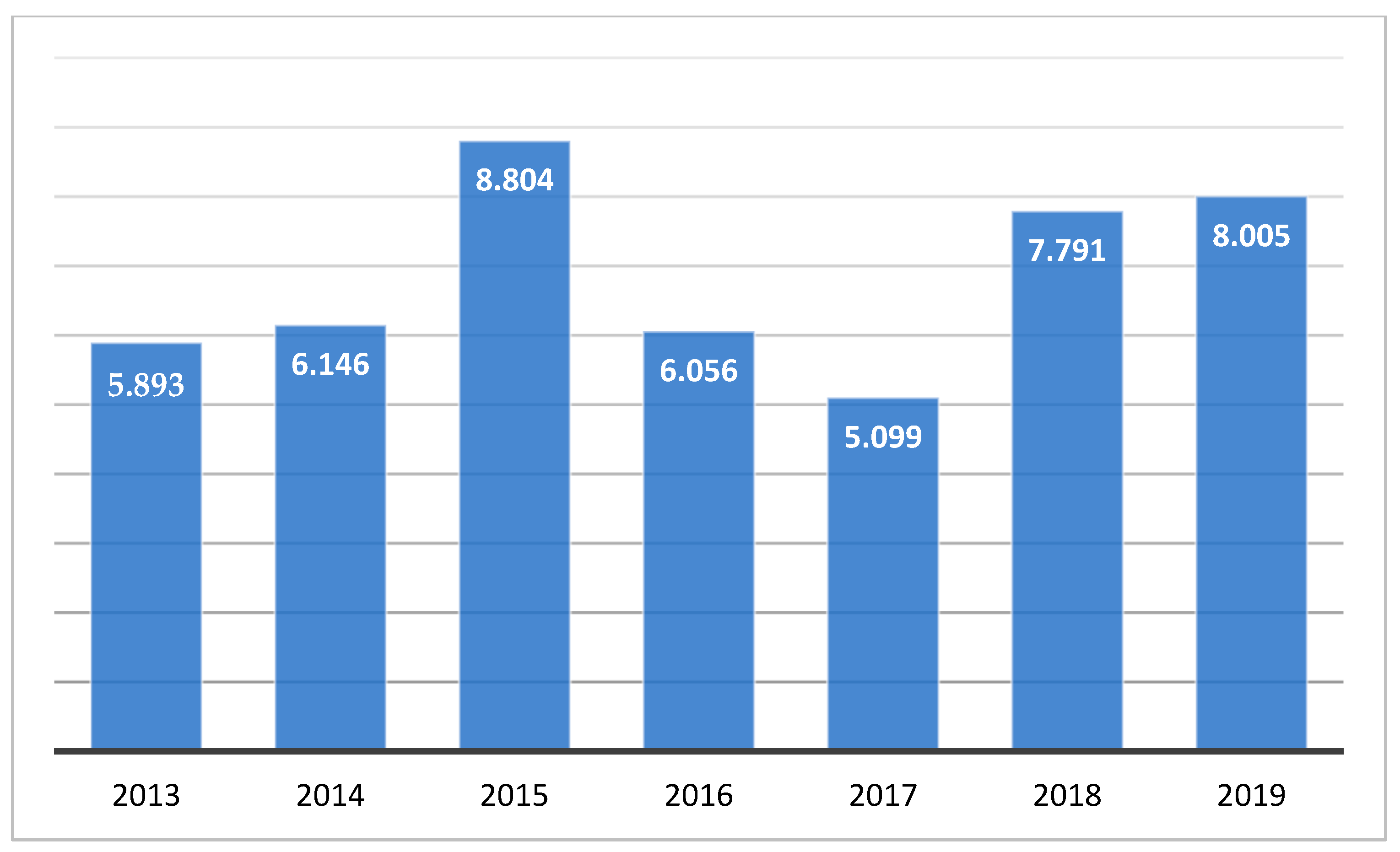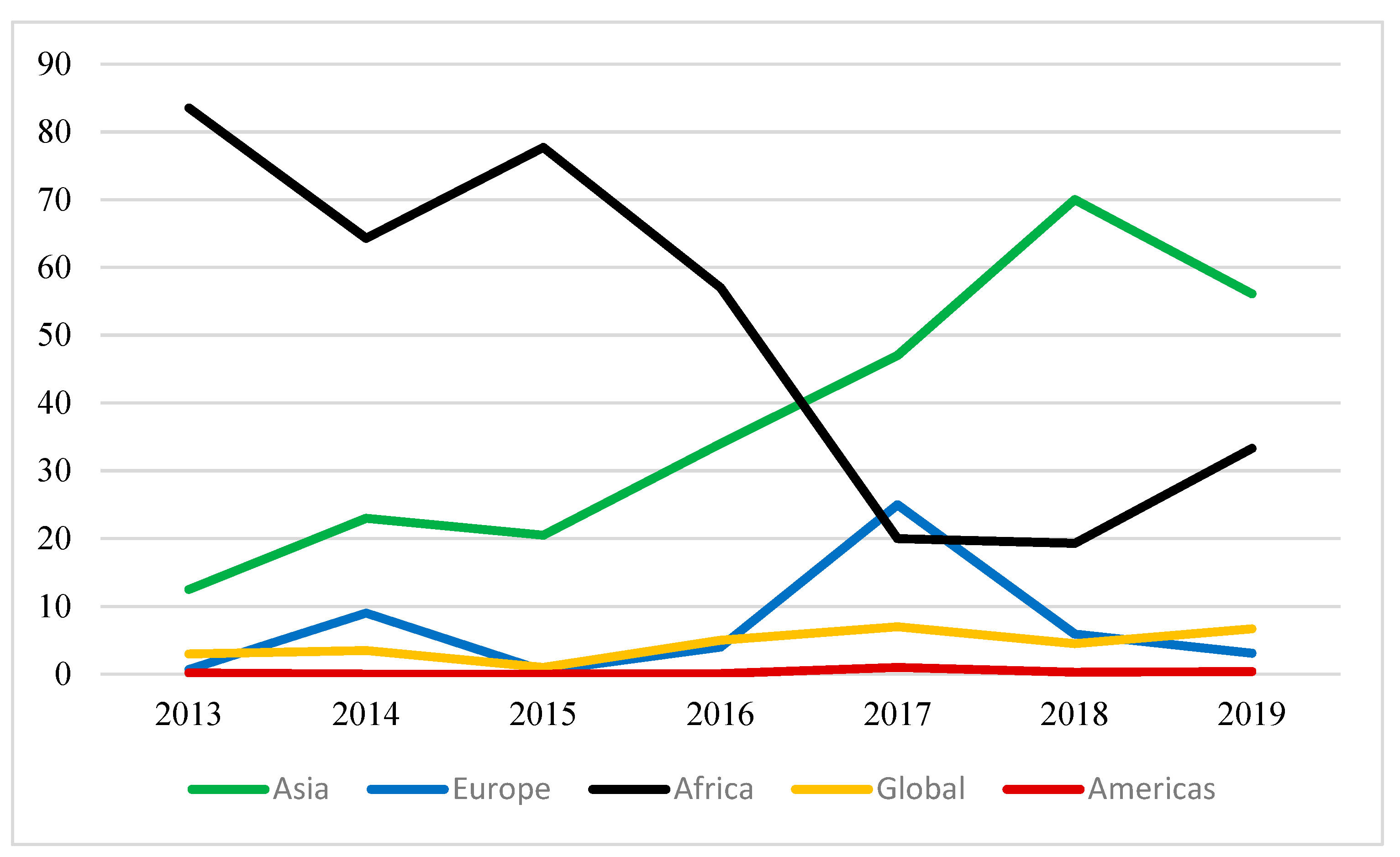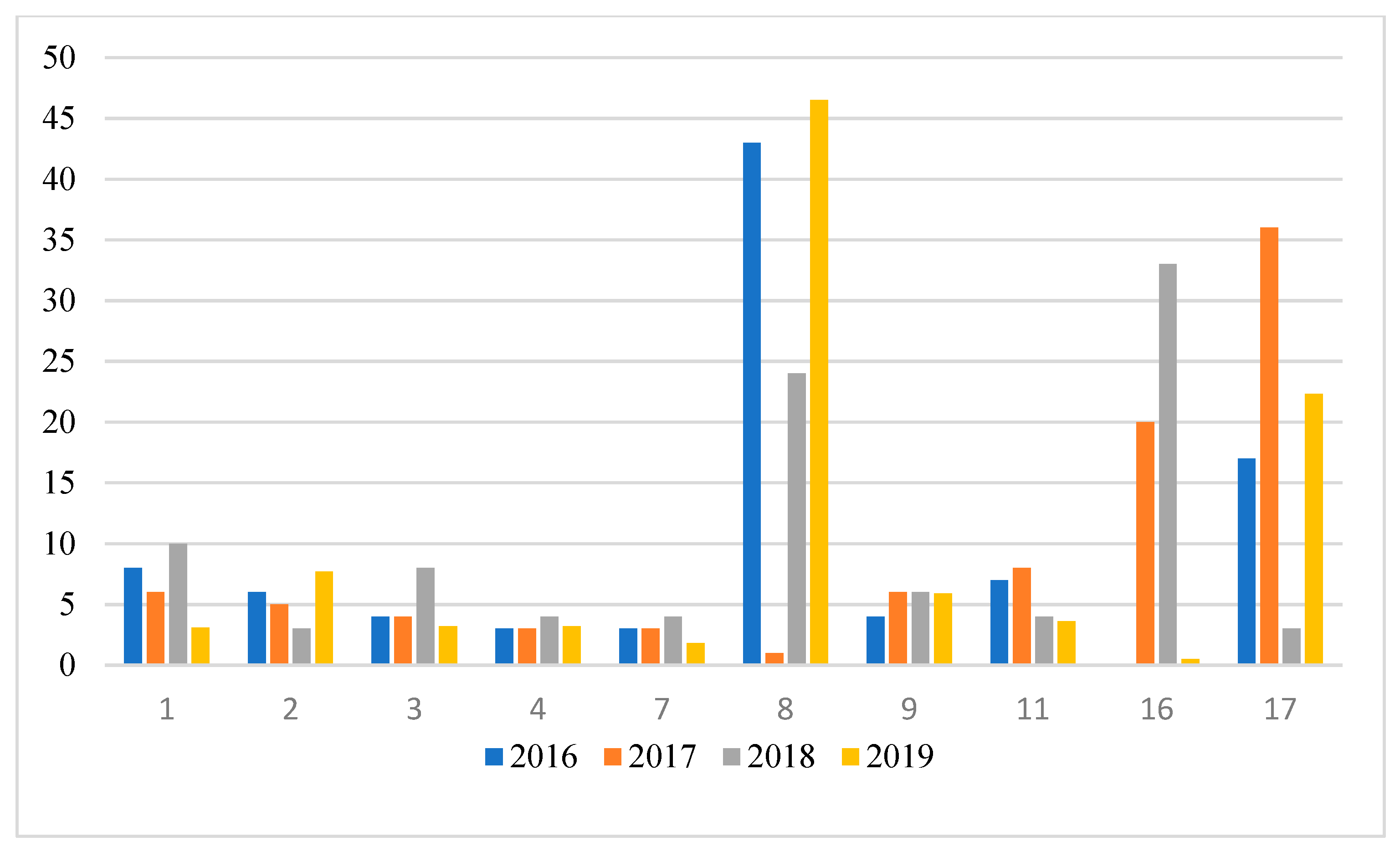Role and Significance of the United Arab Emirates Foreign Aid for Its Soft Power Strategy and Sustainable Development Goals
Abstract
:1. Introduction
2. Materials and Methods
3. Results
3.1. UAE Foreign Policy and Humanitarian Diplomacy
3.1.1. Institutionalization of Foreign Policy and Aid
3.1.2. Humanitarian Diplomacy of the 21st Century
3.1.3. Foreign Aid Strategy 2017–2021
3.2. UAE Soft Power Strategy
3.3. Sustainable Development Goals
3.3.1. Institutional Background
3.3.2. Case Study: UAE-EU Cooperation
4. Discussion: Findings
4.1. Foreign Aid
4.2. Sustainable Development Goals
4.3. Humanitarian Aid during COVID-19 Pandemic
5. Conclusions
Funding
Institutional Review Board Statement
Informed Consent Statement
Data Availability Statement
Conflicts of Interest
References
- Al Zaabi, Fatima, and Raed Awamleh. 2019. Determinants of Soft Power: The Case of United Arab Emirates. In Future Governments. Actions and Insights—Middle East North Africa. Edited by Melodena Stephens, Mona El-Sholkamy, Immanuel Azaad Moonesar and Raed Awamleh. Bingley: Emerald Publishing Limited. [Google Scholar]
- Aldroubi, Mina. 2018. UAE to take the international lead on soft power. The National, December 27. Available online: https://www.thenational.ae/world/gcc/uae-to-take-international-lead-on-soft-power-1.806868(accessed on 7 June 2021).
- Alexander, Kristian, Leonardo Mazzucco, and Maria Jacopo. 2021. Vaccine Diplomacy—The UAE Tries to Balance Hard Times with Soft Power. Insight 261. Available online: https://mei.nus.edu.sg/publication/insight-261-vaccine-diplomacy-the-uae-tries-to-balance-hard-times-with-soft-power/ (accessed on 29 November 2021).
- Alfaham, Tariq. 2019. UAE, EEAS hold first Senior Officials’ Meeting to launch the Cooperation Arrangement. WAM, July 27. Available online: https://www.wam.ae/en/details/1395302776990(accessed on 5 June 2021).
- Almatrooshi, Bader. 2019. The UAE’s Foreign Assistance Policy and Its Contributions to the Sustainable Development Goals. Open Journal of Political Science 9: 669–86. [Google Scholar] [CrossRef] [Green Version]
- Almezaini, Khalid S. 2011. The UAE and Foreign Policy: Foreign Aid, Identities and Interests. Florence: Taylor & Francis Group. [Google Scholar]
- Almezaini, Khalid, and Jean-Marc Rickli, eds. 2017. The Small Gulf States: Foreign and Security Policies before and after the Arab Spring. New York: Routledge. [Google Scholar]
- Baba, Gürol, and Taylan Kaya. 2014. Testing the creativity of Kevin Rudd’s middle power diplomacy: EU–Australia partnership framework versus the Asia-Pacific community. International Relations of the Asia-Pacific 14: 239–69. Available online: https://www.jstor.org/stable/26156016 (accessed on 17 June 2020). [CrossRef] [Green Version]
- Bader, Al-Saif. 2020. The UAE: Aid Serves Many Purposes. In As Gulf Donors Shift Priorities, Arab States Search for Aid. Edited by Michele Dunne. Riad El Solh: Carnegie Endowment for International Peace, Available online: https://carnegie-mec.org/2020/06/09/uae-aid-serves-many-purposes-pub-82004 (accessed on 17 April 2021).
- Bartlett, Will, James Ker-Lindsay, Kristian Alexander, and Tena Prelec. 2017. The UAE as an Emerging Actor in the Western Balkans: The Case of Strategic Investment in Serbia. Journal of Arabian Studies 7: 94–112. Available online: https://doi.org/10.1080/21534764.2017.1322753 (accessed on 7 June 2020). [CrossRef]
- Brand Finance. 2021. Global Soft Power Index 2021. Available online: https://brandirectory.com/globalsoftpower/download/brand-finance-global-soft-power-index-2021.pdf (accessed on 7 May 2021).
- Butter, David. 2020. Egypt and the Gulf. Allies and Rivals. Research Paper 20. Available online: https://www.chathamhouse.org/2020/04/egypt-and-gulf (accessed on 7 January 2021).
- Cochrane, Logan. 2021. The United Arab Emirates as a global donor: What a decade of foreign aid data transparency reveals. Development Studies Research 8: 49–62. [Google Scholar] [CrossRef]
- Conway, Margaret, and Frank Feigert. 1987. Political Analysis: An Introduction. Boston: Allyn and Bacon. [Google Scholar]
- De Lauri, Antonio. 2021. La diplomazia umanitaria. CMI Brief 3: 3. Available online: https://www.cmi.no/publications/7746-la-diplomazia-umanitaria (accessed on 29 November 2021).
- EEAS. 2016. Federica Mogherini, HR/VP meets with Dr. Amal Al Qubaisi, UAE Federal National Council Speaker in Brussels. Press Releases: 160818_2. Available online: https://eeas.europa.eu/topics/security-defence-crisis-response/8363/federica-mogherini-hrvp-meets-dr-amal-al-qubaisi-uae-federal-national-council-speaker-brussels_en (accessed on 15 June 2020).
- EEAS. 2018. EU and UAE sign a Cooperation Arrangement. Press Releases: 180131_15. Available online: https://eeas.europa.eu/headquarters/headquarters-homepage/39170/press-release-eu-and-uae-sign-cooperation-arrangement_et (accessed on 15 June 2020).
- Elserougy, Magdy. 2021. MoFAIC-Bericht: Die Auslandshilfe der VAE Belief Sich von 2010 bis 2021 auf 206 Milliarden AED. Available online: https://www.wam.ae/de/details/1395302963143 (accessed on 29 November 2021).
- Esraa, Ismail, and Abubaker Rasha. 2019. UAE a global model for promoting peace through humanitarian role in Yemen, says EU President. WAM, January 14. Available online: http://wam.ae/en/details/1395302732327(accessed on 17 June 2020).
- Evans, Gareth, and Grant Bruce. 1991. Australia’s Foreign Relations in the World of the 1990s. Carlton, Victoria: Melbourne University Press. [Google Scholar]
- Forrey, Danielle. 2020. The UAE’s History of Foreign Aid Assistance. Borgen Project. Available online: https://borgenproject.org/tag/uae-humanitarian-committee/ (accessed on 17 January 2021).
- Frantzman, Seth. 2020. UAE-Egypt relations grow with Sheikh Mohamed bin Zayed visit to Sisi. The Cairo-Abu Dhabi relationship has grown strong. Jerusalem Post, December 17. Available online: https://www.jpost.com/middle-east/uae-egypt-relations-grow-with-sheikh-mohamed-bin-zayed-visit-to-sisi-652421(accessed on 7 May 2021).
- Gibbins, Justin. 2017. Power play: The United Arab Emirates’ new approach to geopolitics. Journal of Middle Eastern Politics and Policy. Available online: http://hksjmepp.com/united-arab-emirates-geopolitics/ (accessed on 7 August 2020).
- Godinho, Varun. 2021. UAE’s foreign aid from 2010 to 2021 totalled $56.14bn. Gulf Business. Available online: https://gulfbusiness.com/uaes-foreign-aid-from-2010-to-2021-totalled-56-14bn/#:~:text=The%20value%20of%20foreign%20aid,and%20International%20Cooperation%20(MoFAIC) (accessed on 29 November 2021).
- Gökalp, Deniz. 2020. The UAE’s Humanitarian Diplomacy: Claiming State Sovereignty, Regional Leverage and International Recognition. CMI Working Paper no 1. February. Available online: https://www.cmi.no/publications/7169-the-uaes-humanitarian-diplomacy-claiming-state-sovereignty (accessed on 14 May 2021).
- Göll, Edgar, André Uhl, and Jakob Zwiers. 2019. Sustainable Development in the MENA Region. MENARA Future Notes. Available online: http://menaraproject.eu/wp-content/uploads/2019/03/menara_fn_20.pdf (accessed on 14 August 2021).
- Gulf News. 2017. UAE’s Soft Power Strategy discussed. Gulf News, September 26. Available online: https://gulfnews.com/uae/government/uaes-soft-power-strategy-discussed-1.2096694(accessed on 8 August 2020).
- Günek, Abdulsamet. 2018. A New Type of Soft Power: Country Branding. International Journal of Cultural and Social Studies 4: 252–59. Available online: https://dergipark.org.tr/download/article-file/525907 (accessed on 18 August 2020).
- Hertog, Steffen. 2017. A Quest for Significance: Gulf Oil Monarchies’ International ‘Soft Power’ Strategies and Their Local Urban Dimensions. LSE Kuwait Programme Paper Series 42; London: The London School of Economics and Political Science, LSE Kuwait Programme. [Google Scholar]
- Kamrava, Mehran. 2013. Qatar: Small State, Big Politics. Ithaca and London: Cornell University Press. [Google Scholar]
- Katzenstein, Peter. 1985. Small States in World Markets. Ithaca: Cornel University Press. [Google Scholar]
- Keohane, Nannerl. 2012. Thinking about Leadership. Princeton: Princeton University Press. [Google Scholar]
- Kodabux, Adeelah. 2019. The Future of IR Lies in Creativity Rather than ‘New Thinking’. E-International Relations. Available online: https://www.e-ir.info/2019/11/11/the-future-of-ir-lies-in-creativity-rather-than-new-thinking/ (accessed on 17 August 2020).
- Krzymowski, Adam. 2020a. Expo2020 Dubai on the journey to achieve the United Arab Emirates’ Soft Superpower. University of Sharjah Journal for Humanities & Social Sciences 17: 1–21. [Google Scholar]
- Krzymowski, Adam. 2020b. Sustainable Development Goals in Arab Region–United Arab Emirates’ Case Study. Problemy Ekorozwoju–Problems of Sustainable Development 15: 211–20. [Google Scholar] [CrossRef]
- Krzymowski, Adam. 2020c. The European Union and the United Arab Emirates as civilian and soft powers engaged in Sustainable Development Goals. Journal of International Studies 13: 41–58. [Google Scholar] [CrossRef] [PubMed]
- Lootah, Abulla Nasser. 2019. Excellence in Implementation’: The UAE Model in Reaching the Global Agenda 2030. In EDA Reflection. Abu Dhabi: Emirates Diplomatic Academy. [Google Scholar]
- Mills, Robin. 2017. Global Governance of Carbon Capture and Storage: Role for the GCC? In EDA Insight. Abu Dhabi: Emirates Diplomatic Academy, vol. 8. [Google Scholar]
- MOFAIC. 2017a. Promoting Global Peace and Prosperity. UAE Policy for Foreign Assistance 2017–2021. Abu Dhabi: United Arab Emirates Ministry of Foreign Affairs and International Cooperation. [Google Scholar]
- MOFAIC. 2017b. United Arab Emirates Foreign Aid 2016. Abu Dhabi: Ministry of Foreign Affairs and International Cooperation. [Google Scholar]
- MOFAIC. 2018. United Arab Emirates Foreign Aid 2017. Abu Dhabi: Ministry of Foreign Affairs and International Cooperation. [Google Scholar]
- MOFAIC. 2019. United Arab Emirates Foreign Aid 2018. Abu Dhabi: Ministry of Foreign Affairs and International Cooperation. [Google Scholar]
- MOFAIC. 2020. United Arab Emirates Foreign Aid 2019. Abu Dhabi: Ministry of Foreign Affairs and International Cooperation. [Google Scholar]
- Mouriadou, Georgia. 2016. EU-GCC Clean Energy Technology Network. Working Groups Consultation Workshop. Available online: http://www.eugcc-cleanergy.net/wg-workshop2016%2CDubai (accessed on 15 August 2020).
- Nye, Joseph. 2004. Soft Power: The Means to Success in World Politics. Foreign Affairs, May/June. [Google Scholar]
- Rosenau, James. 1981. The Study of Political Adaptation. London: Pinter, New York: Nichols. [Google Scholar]
- Saberi, Donya, Cody Morris Paris, and Belisa Marochi. 2018. Soft power and place branding in the United Arab Emirates: Examples of the tourism and film industries. International Journal of Diplomacy and Economy 4: 44–58. [Google Scholar] [CrossRef]
- Sahu, Mrutuyanjaya. 2021. Public policy measures for COVID-19 crisis management: Lessons from the UAE. Fulbright Review of Economics and Policy 1: 246–65. Available online: https://www.emerald.com/insight/content/doi/10.1108/FREP-09-2021-0054/full/html (accessed on 29 November 2021). [CrossRef]
- Sanz, Alba. 2021. Les EAU ont accordé plus de 54 milliards de dollars d’aide étrangère. Available online: https://atalayar.com/fr/content/les-eau-ont-accord%C3%A9-plus-de-54-milliards-de-dollars-daide-%C3%A9trang%C3%A8re (accessed on 29 November 2021).
- Sheena, Amos. 2019. UAE ranked world’s top aid donor in 2017: OECD. Dubai Gazette, January 11. Available online: https://dubaigazette.com/uae-ranked-worlds-top-aid-donor-in-2017-oecd/(accessed on 11 August 2020).
- Stur, Beata. 2017. Jyrki Katainen: ‘There is untapped trade potential between GCC and Europe. NewEurope, January 30. Available online: https://www.neweurope.eu/article/jyrki-katainen-untapped-trade-potential-gcc-europe/(accessed on 7 August 2020).
- SWFI. 2019. Top 81 Largest Sovereign Wealth Fund Rankings by Total Assets. SWIFI Institute. Available online: https://www.swfinstitute.org/fund-rankings/sovereign-wealth-fund (accessed on 17 August 2020).
- The National. 2018. UAE is the world’s top donor of development aid in 2017, report shows. The National, April 9. Available online: https://www.thenational.ae/uae/government/uae-is-world-s-top-donor-of-development-aid-in-2017-report-shows-1.720143(accessed on 7 June 2020).
- U.AE. 2019. Centres for Countering Extremism. Available online: https://u.ae/en/about-the-uae/culture/tolerance/centers-for-countering-extremism (accessed on 29 November 2021).
- U.AE. 2021. الجهود الإنسانية لدولة الإمارات خلال جائحة كوفيد-19. Available online: https://u.ae/en/information-and-services/justice-safety-and-the-law/handling-the-covid-19-outbreak/humanitarian-efforts#:~:text=The%20UAE%20was%20one%20of,when%20COVID%2D19%20broke%20out.&text=As%20of%20July%202021%2C%20the,135%20countries%20around%20the%20world (accessed on 29 November 2021).
- Ulrichsen, Kristian Coates. 2017. The United Arab Emirates: Power, Politics and Policy-Making. New York: Routledge. [Google Scholar]
- UNDP. 2021. Funding Facility for Stabilization. Available online: https://www.iq.undp.org/content/iraq/en/home/all-projects/funding-facility-for-stabilization.html (accessed on 7 September 2021).
- Walker, Stephen, ed. 1987. Role Theory and Foreign Policy Analysis. Durham: Duke University Press. [Google Scholar]
- Woodward, Richard. 2018. The UAE—Soft Superpower in The Making? TRENDS Research & Advisory, May 30. Available online: http://trendsinstitution.org/the-uae-soft-superpower-in-the-making/(accessed on 7 July 2020).





Publisher’s Note: MDPI stays neutral with regard to jurisdictional claims in published maps and institutional affiliations. |
© 2022 by the author. Licensee MDPI, Basel, Switzerland. This article is an open access article distributed under the terms and conditions of the Creative Commons Attribution (CC BY) license (https://creativecommons.org/licenses/by/4.0/).
Share and Cite
Krzymowski, A. Role and Significance of the United Arab Emirates Foreign Aid for Its Soft Power Strategy and Sustainable Development Goals. Soc. Sci. 2022, 11, 48. https://doi.org/10.3390/socsci11020048
Krzymowski A. Role and Significance of the United Arab Emirates Foreign Aid for Its Soft Power Strategy and Sustainable Development Goals. Social Sciences. 2022; 11(2):48. https://doi.org/10.3390/socsci11020048
Chicago/Turabian StyleKrzymowski, Adam. 2022. "Role and Significance of the United Arab Emirates Foreign Aid for Its Soft Power Strategy and Sustainable Development Goals" Social Sciences 11, no. 2: 48. https://doi.org/10.3390/socsci11020048
APA StyleKrzymowski, A. (2022). Role and Significance of the United Arab Emirates Foreign Aid for Its Soft Power Strategy and Sustainable Development Goals. Social Sciences, 11(2), 48. https://doi.org/10.3390/socsci11020048





